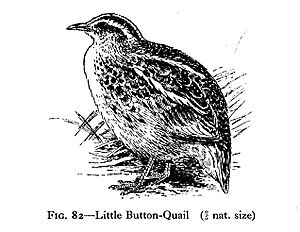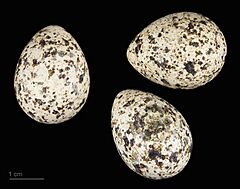Common buttonquail facts for kids
Quick facts for kids Common buttonquail |
|
|---|---|
 |
|
| Conservation status | |
| Scientific classification | |
| Genus: |
Turnix
|
| Species: |
sylvaticus
|
| Synonyms | |
|
Turnix sylvatica |
|
The common buttonquail (Turnix sylvaticus) is a small bird that looks a lot like a quail. However, it's actually part of a different bird family called buttonquails. People also call it the Kurrichane buttonquail, small buttonquail, or Andalusian hemipode.
Contents
About the Common Buttonquail
The common buttonquail was first officially described in 1789 by a French scientist named René Louiche Desfontaines. He gave it the scientific name Tetrao sylvaticus. The word sylvaticus comes from Latin and means "of the woods." Later, in 1840, the bird was placed in its current group, or genus, called Turnix.
There are nine different types, or subspecies, of the common buttonquail. These different types live in various parts of the world. For example, one type lives in southern Spain and northwest Africa, while others are found across Africa, Asia, and the Philippines.
What Does It Look Like?
The common buttonquail is a small bird, only about 15 centimeters (6 inches) long. It looks similar to the common quail. Its upper body is sandy brown with streaks, helping it blend in with its surroundings. Its belly is a buff color, and it has black marks on its sides. Its face is plain.
When it flies, you might notice a white bar on its wing that stands out against its gray wings. Both male and female buttonquails look alike. Young birds, however, have more spots on their undersides. This tiny bird is known for being very hard to spot because it prefers to run and hide rather than fly.
Where Do They Live?
These birds live in many places around the world. You can find them from southern Spain and Africa all the way through India and tropical Asia to Indonesia.
Common buttonquails like to live in warm grasslands or areas with low bushes and plants. They avoid thick forests and hilly places. They prefer open grassy plains or even cornfields. They eat insects and seeds.
How Do They Behave?
The common buttonquail is a very shy bird. It likes to hide and is hard to find. If you get too close, it might suddenly fly up from near your feet. When it flies, it stays low to the ground and quickly lands again. After it lands, it's very difficult to make it fly a second time.
The female buttonquail makes a deep "hoom-hoom-hoom" sound. The male bird replies with a "kek-kek-kek" sound.
Raising Young Birds
The female buttonquail is the one who starts the courtship. She also builds the nest on the ground. The male bird then takes care of the eggs. He sits on them to keep them warm until they hatch. There are usually four grayish eggs with speckles.
The baby birds can run as soon as they hatch! The nesting season for these birds is usually from June to September. The nest is a small pad of grass placed in a natural dip in the ground. It's often hidden among the stems of a clump of grass. Sometimes, the grass is even bent over the nest to create a small roof.
Protecting the Species
The common buttonquail is found in many places, so globally, it's listed as a species of "least concern" by the IUCN Red List of Threatened Species. This means it's not in immediate danger of disappearing worldwide.
However, the type of common buttonquail that lives in the Mediterranean region is in serious trouble. It's considered "critically endangered." This specific group of birds has almost disappeared from most of its home range during the 1900s. As of 2018, Spain officially declared that the species was extinct there. In 2021, the IUCN also announced that the common buttonquail is now extinct in Europe. This makes it the first bird species to become extinct in Europe since the Great Auk in 1852.
Gallery
-
A painting of the common buttonquail by John Gould.








